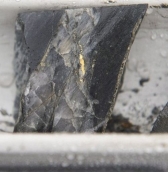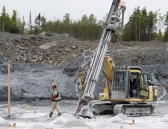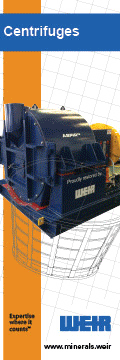Nova Scotia’s New Gold Rush: Seeking Riches in Flecks of Metals

At these open-pit mines, tiny bits of gold are found in larger, otherwise unremarkable hunks of ore.
[Click image to enlarge]

Workers prepare a blast at Atlantic Gold Corporation's Touquoy open pit gold mine in Moose River Gold Mines, N.S.
[Click image to enlarge]
Amid the dull claystone of a tube-shaped sample of rock, the gleaming, pulse-quickening swirl of gold is unmistakable.
“It’s quite a special specimen of gold — it’s by far the best visible section of gold we’ve ever intersected,” said Tim Bourque, a geologist with Atlantic Gold Corp, cradling the meter-long sample in his arms.
The rock was gathered last fall at the firm’s Fifteen Mile Lake property, one of four deposits it owns in Nova Scotia’s old gold districts.
The discovery of the precious metal in such unremarkable hunks of stone is helping to revive a dormant industry — and Bourque hopes it will keep the company’s Moose River Consolidated Project flourishing after its initial Touquoy mine starts up here in September.
The company says Touquoy will stamp out 87,000 ounces of gold in its first year — each ounce worth more than $1,200 (U.S.) each — an indication of the potential riches that have drawn Atlantic Gold and other miners to the interior of the province’s Eastern Shore region.
The number of provincial exploration licenses shot up from 259, covering 35,000 hectares, to 417 licenses covering almost 97,000 hectares last year. Those include other minerals, but the Department of Natural Resources says “gold is a target for many.”
Another mining company, Newfoundland-based Anaconda, has purchased a gold mine in Goldboro, 185 kilometers northeast of Halifax, with plans to mine and ship ore from the site to its central processing site in Newfoundland within three years.
Nova Scotia’s 21st century gold industry differs from the era of underground shafts at Moose River Gold Mines, the site of a world-famous 1936 cave-in that trapped three men and led to the live broadcast of a dramatic rescue that was heard across the continent.
Geologists are now seeking tiny flecks of the precious metal in the folds of ordinary, “host” rock that held the quartz, rather than exclusively in the quartz veins that characterize underground gold mines.
The new Moose River mines are open pits the size of multiple football fields, using daily explosions to extract tonnes of ore along with a mass crushing and leaching to draw out tiny amounts of gold.
The concept relies on massive volumes of ore, a standardization of crushing methods that keep costs down, proximity to ports and cities — Halifax is less than 90 minutes away — and a relatively strong gold price.
John Wightman, executive director of the Nova Scotia Prospectors Association, says the old-timers who ran the underground mines in places like Moose River, Caribou or Goldboro in the last century never would have imagined the scene unfolding near their idled shafts.
“We’re looking at deposits for the most part that are disseminated gold, which means the grade is low compared to traditional mines,” he said.
At the Touquoy site, pits have been blasted deep into the ground.
During a tour, Chief Operations Officer Maryse Belanger says about 25,000 tonnes of ore will start to be moved around the grounds each day this fall.
Some will go to build the dam being erected in the distance, other portions go into construction on the site and about a quarter will be put through a processing plant being built on higher ground.
“Open pit mining here in Nova Scotia is part of redefining what the (Canadian) industry can do,” she said, as she stands in front of grey rock face where the first ore will be blasted into 15-centimetre chunks.
She says after her firm assembled a series of properties in 2014 in the center of the province, it was able to raise about $150 million in investment.
Those funds pay for a processing plant built by Australia’s Ausenco firm, where massive quantities of ore will be pulverized. The flecks of gold that gravity and crushing can’t extract is drawn away by cyanide flowing through tanks.
Each tonne of rock averages about 1.45 grams of gold — roughly the equivalent of a few paper clips next to an adult elephant.
The gold will be stored in a windowless, three-story building where furnaces are to create the bullion bars before they’re stored in a thick cement vault currently under construction.
Retiree Barbara Markovits says nitrogen in the effluent — in part from the explosives — may lead to unnatural enrichment of surrounding waters, leading to potential fish kills.
Belanger says the company’s response to environmental issues will be posted “in the coming weeks,” and that its proposed hauling route “does not pass by any existing homes.”
But amidst environmental concerns, there are also Nova Scotia mining professionals grateful for the chance to return home for work.
— By: Michael Tutton, The Canadian Press




















